If you’re in the market for a new project management tool and are stuck between two solid options like Asana and Jira, we’ve collected all the details you need to make a well-informed decision.
Asana, a task management tool, helps teams tackle projects one task and subtask at a time. Jira, a project and issue-tracking software by Atlassian, primarily helps development teams track bugs that arise in programs so that they can be dealt with collaboratively. Both sound like good options, but which one is good for you? Keep reading our complete comparison to see which is most fitting for your needs and why an alternative platform like monday dev may be your best bet after all.
Try monday devKey Takeaways: Jira vs Asana
- Asana is geared towards general task management and team collaboration, while Jira is designed for software development teams and focused on bug tracking and Agile project management
- Both platforms offer effective solutions, with Asana being a little simpler than Jira, but Jira coming out as more robust with way more integration options, DevOps features, and more
- For larger teams, Jira comes with a heftier price tag than Asana, making it a significant investment for teams, something to take into consideration when weighing both options
Pitting two great project management tools against each other is a tricky thing to do. It’s tough to say whether one solution is overall better than the other since each one caters to distinct needs and could be the right fit for different teams.
Still, it’s important to decide which platform is the best for your team, specifically, by breaking down different elements of each platform. That’s where this Asana vs. Jira guide comes in handy. By the end of this article, you’ll have a better understanding of both platforms so that you can see which one is the best fit for you.
At a glance: Asana vs. Jira
Here’s a quick overview of each software’s need-to-know details for you to compare side-by-side. For a more detailed breakdown of each tool, keep on scrolling down.
| Asana | Jira | |
| Ideal use case | General project and task management | Software development project management |
| Integrations | 200+ | 3,000+ |
| Pricing | Free Basic plan, paid plans starting at $10.99/user/month | Free Basic plan, paid plans starting at $7.16/user/month |
| Features | ||
| Storage | Unlimited storage of 100MB per file on all plans, including free | Free: 2GB Standard: 250 GB Unlimited storage on higher-tiered plans |
| Work views | 9 work views including List, Board, Timeline, Gantt, and more | 6 work views, including Backlog, List, Board, Timeline, and more |
| Ease of use | Simple to use, some users find it takes time to learn, less ideal for complex projects | Easy to use, quickstart bar to help with tasks, less intuitive interface |
| Customer support | Several contact options and customer resources, generally favorable customer service reviews | Online support form, level of service depends on chosen plan with phone support for Enterprise level |
| Customer reviews | 4.4/5 on G2 | 4.3/5 on G2 |
Most robust features: Jira
Verdict: While both Asana and Jira have no shortage of useful features, Jira is little more robust and offers more development-specific tools
While both Asana and Jira are used for project management purposes, their intended uses are slightly different. Asana is focused more on helping teams work on tasks while Jira helps teams focus on fixing bugs. Let’s take a more in-depth look at each project management solution’s standout features.
Asana features
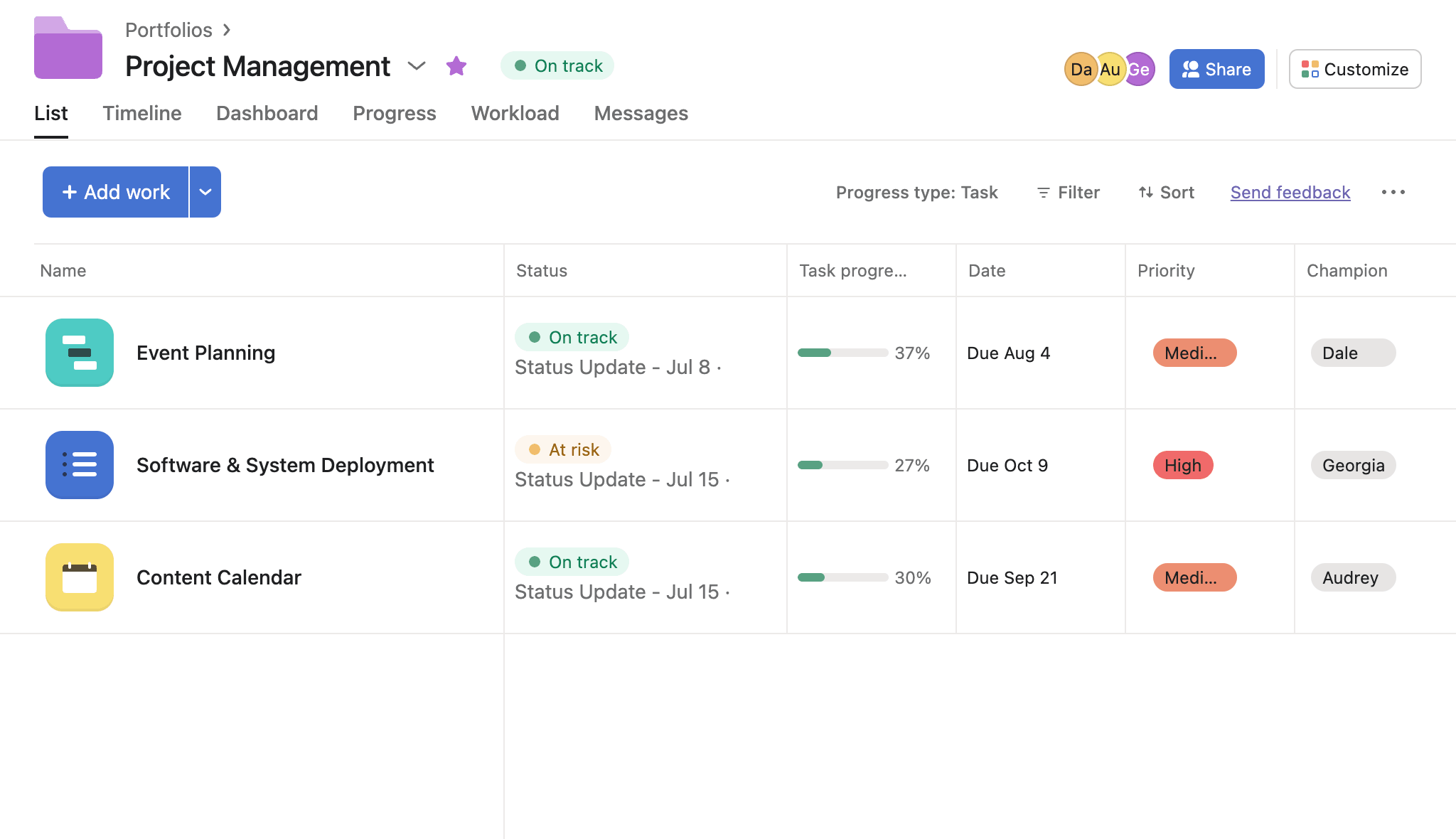
With Asana, teams can collaborate on tasks and subtasks without all the extra features some alternative project management tools offer. This enables teams to cut through the noise and focus on what matters. Asana’s features are built to make collaboration easy and painless, here are a few of them:
- Task management: Break down projects into bite-sized tasks to make work more manageable. You can assign tasks, break them up into smaller steps called subtasks, group them into sections, set deadlines, add custom fields, attachments, and more.
- Team collaboration: Asana includes features like multiple timeline and board views to help you get an overview of team tasks, as well as a goal-setting feature that helps teams stay aligned and collaborate on reaching targets.
- Analytics and reporting: Run reports to see how a team is performing and how tasks are progressing. You can also monitor the status of tasks in real-time to help keep your initiatives on track.
- Workflow builder: Asana enables teams to set their own customizable workflows so that you can create your own work process between teams using automation and visual tools.
- Automation: Users can create their own automations, which Asana calls “Rules,” to keep teams working efficiently by removing the need to spend time on manual tasks.
Related: Asana work management
Jira features
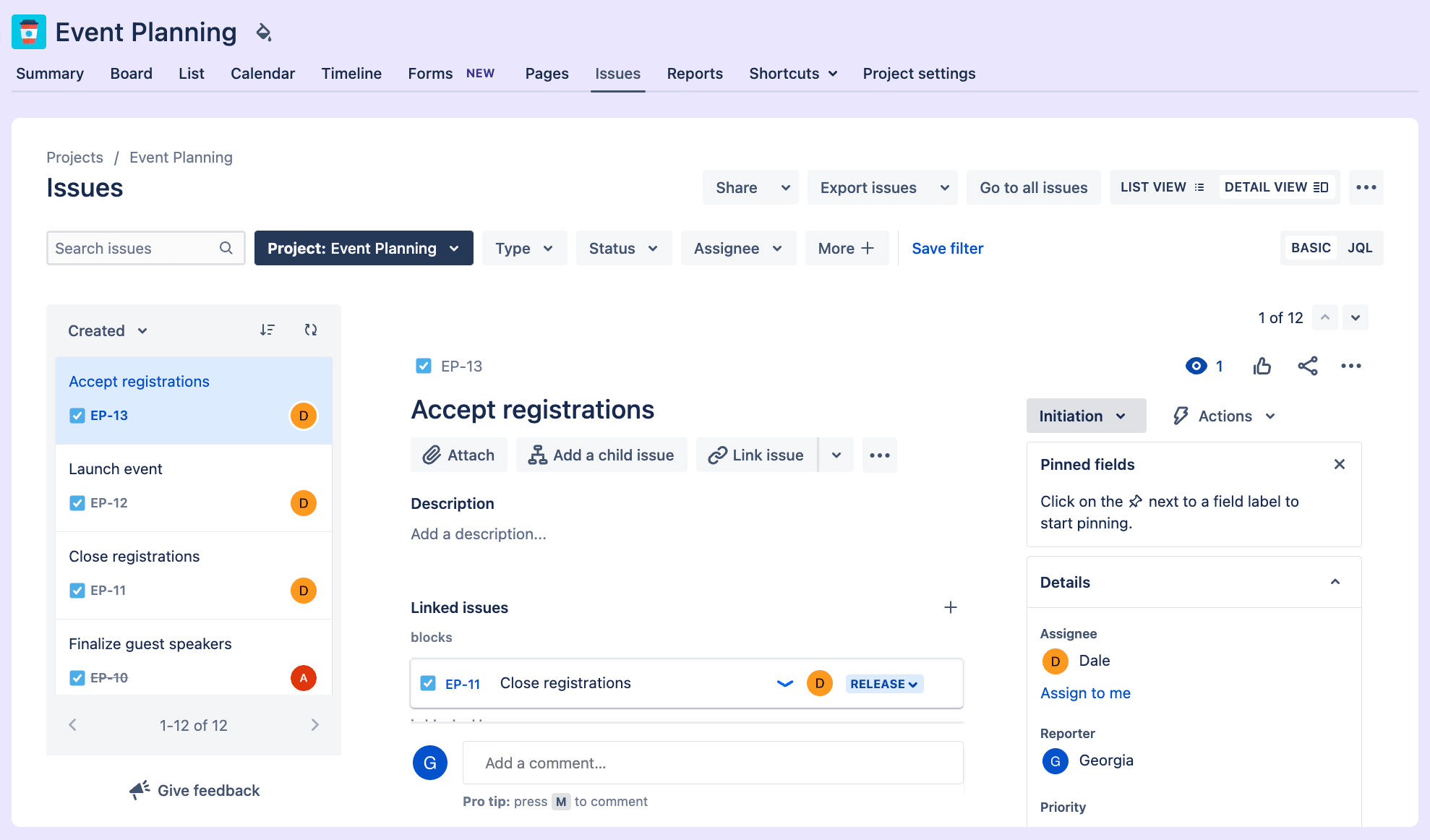
While Jira is positioned as a bug-tracking app, it still has multiple advanced features that make it ideal for general project management. Here’s a closer look at some of Jira’s best features:
- DevOps features: Development teams can view repositories, issues, development statuses, and visualize progress all in one unified place.
- Scrum boards: With Jira’s scrum boards, teams can benefit from an agile project management methodology and deliver projects quickly when working in sprints.
- Roadmaps: Jira’s interactive roadmap allows users to map out work tasks and dependencies in an organized timeline to help keep team members synced.
- Drag and drop automations: Building your own automations is simple in Jira as users can drag and drop automation instructions, start from templates, and even connect external work tools.
- Reports and insights: Get insight into your work, even during a sprint, to optimize efficiency. Jira’s robust reporting allows teams to pull reports for sprints, burndowns, releases, and more.
Related: Jira Work Management, Jira alternatives
Try monday devMost integration options: Jira
Verdict: Jira simply has more to offer in the way of features, offering a marketplace of 3,000+ app integrations compared to Asana’s 200+
Integrations are an important factor to consider when shopping around for a project management solution. You likely already use a number of different work and collaboration tools, so the solution you choose should help you use them all in one place.
A project management tool that allows you to integrate with products you already use will help you minimize the onboarding process and keep your workflow running smoothly.
Both Asana and Jira have many integration options, and they also both offer integrations for each other, so if you can’t decide on one software, you can use both!
Asana integrations
With over 200 apps to choose from, Asana has tons of integrations with some of the most popular work apps, like Trello, Mailchimp, Loom, Zapier, Salesforce, Microsoft apps, and more. Asana’s app offerings focus more on the tools that teams might use in general rather than integrations for more industry-specific tools, like development apps, which is where Jira shines.
Jira integrations
Unsurprisingly, Jira’s integrations are more catered to developers so users will find a wider variety of technical apps. Boasting over 3,000 app integrations, Jira seems to have an app for everything, such as GitLab, Timesheet Tracking, draw.io, Zephyr Scale, Scriptrunner, and others, including many of the popular integrations Asana offers.
Most affordable: Depends on your plan
Verdict: Both Asana and Jira offer free plans, Jira’s plans are cheaper per user, but when you get to Enterprise level, Jira becomes a pricier option
| Asana | Jira | |
| Free plan | Yes | Yes |
| Starting price | $10.99/user | $7.16/user |
| Second tiered plan | $24.99/user | $12.48/user |
| Features | Custom pricing | Starting from $141,000 |
Cost is an important consideration when shopping for software, but before comparing prices, it’s important to know what the price includes. Let’s break down what you can expect to pay for Asana and Jira and what the different tiers include.
Asana pricing
Here’s a breakdown of Asana pricing for different plans available on the platform:
- Basic: For individuals or teams of less than 15, Asana offers its Basic plan for free “forever,” and includes unlimited storage, access to its iOS and Android mobile apps, and unlimited projects
- Premium: Asana’s Premium plan costs $10.99 per user per month, and grants access to forms, dashboards, and inviting unlimited free guests
- Business: Asana’s Business plan sets teams back $24.99 per user per month, offering advanced integrations with Salesforce and Tableau, customizing forms, time tracking, and advanced reporting
- Enterprise: There aren’t huge differences between the Business and Enterprise plans, except that the Enterprise plan includes User provisioning & de-provisioning (SCIM) and priority support, but the cost isn’t listed and organizations need to contact Asana for a custom quote
Jira pricing
Plans look similar to Asana’s when working with a lower number of users, but Jira pricing works on a sliding scale where organizations pay less per user the more users they have. Let’s look at Jira’s plans:
- Basic: Jira’s Basic plan is also free, albeit only for teams of up to 10, and has a limit of 2 GB of file storage
- Standard: Jira’s Standard plan starts at $7.16 per user per month for up to 35,000 users, and offers customer support during local business hours. It includes 250 GB of storage, audit logs, the ability to set user roles and permissions, and anonymous access, which is used to give customers the ability to view and submit bugs and feature requests
- Premium: The Premium plan starts at $12.48 per user, granting users the ability to archive projects, unlimited file storage, and 24/7 premium support
- Enterprise: The Enterprise plan is available only on annual billing and has a minimum of 801 users with a price tag of $141,000. The price includes 24/7 enterprise support, centralized security controls and user subscriptions, unlimited sites, and more.
Still looking for a Jira and Asana alternative and figuring out which plan is best for you? Compare both platforms against monday.com to see how they stack up.
Related: Asana pricing
Easiest to use: Asana
Verdict: Asana is easier to use with a lower average learning curve and a more user-friendly interface
While neither Asana nor Jira is particularly difficult to use, some users feel it’s easier to use one software over the other. Here’s a closer look at the usability of each software.
Asana ease of use
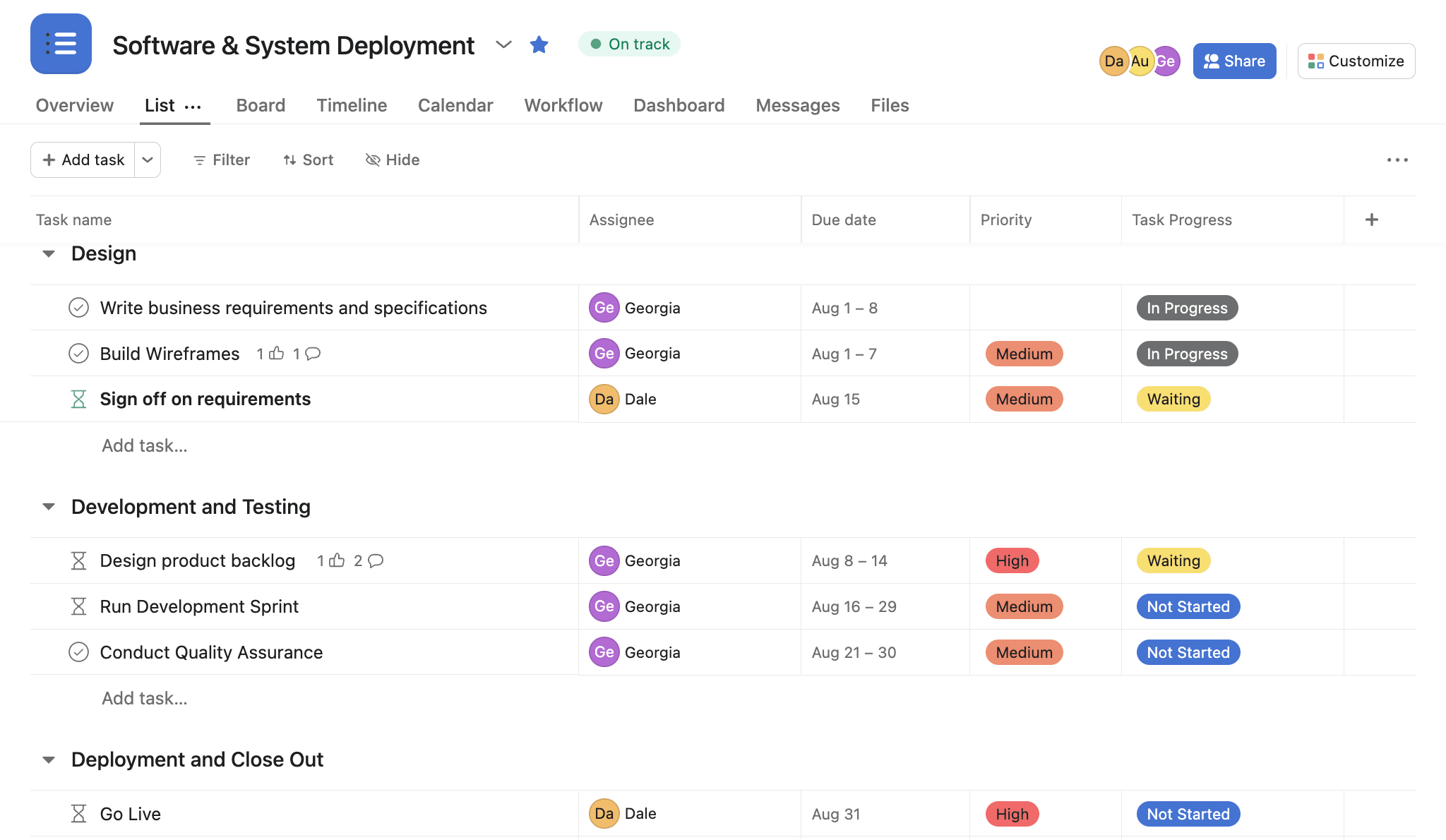
Asana users note that the software is easy to use without skimping on important project management functionalities. Some users have noted that it takes some getting used to. According to an Asana user on TrustRadius, the software “was not as intuitive to understand and start using as [they] thought it would be.”
Users who are unfamiliar with the platform might need help getting started, but once they get the hang of it Asana is known to be quite user-friendly. Still, users looking for more complex project management solutions have found that Asana lacked some of the tools needed to make for a positive user experience.
Jira ease of use
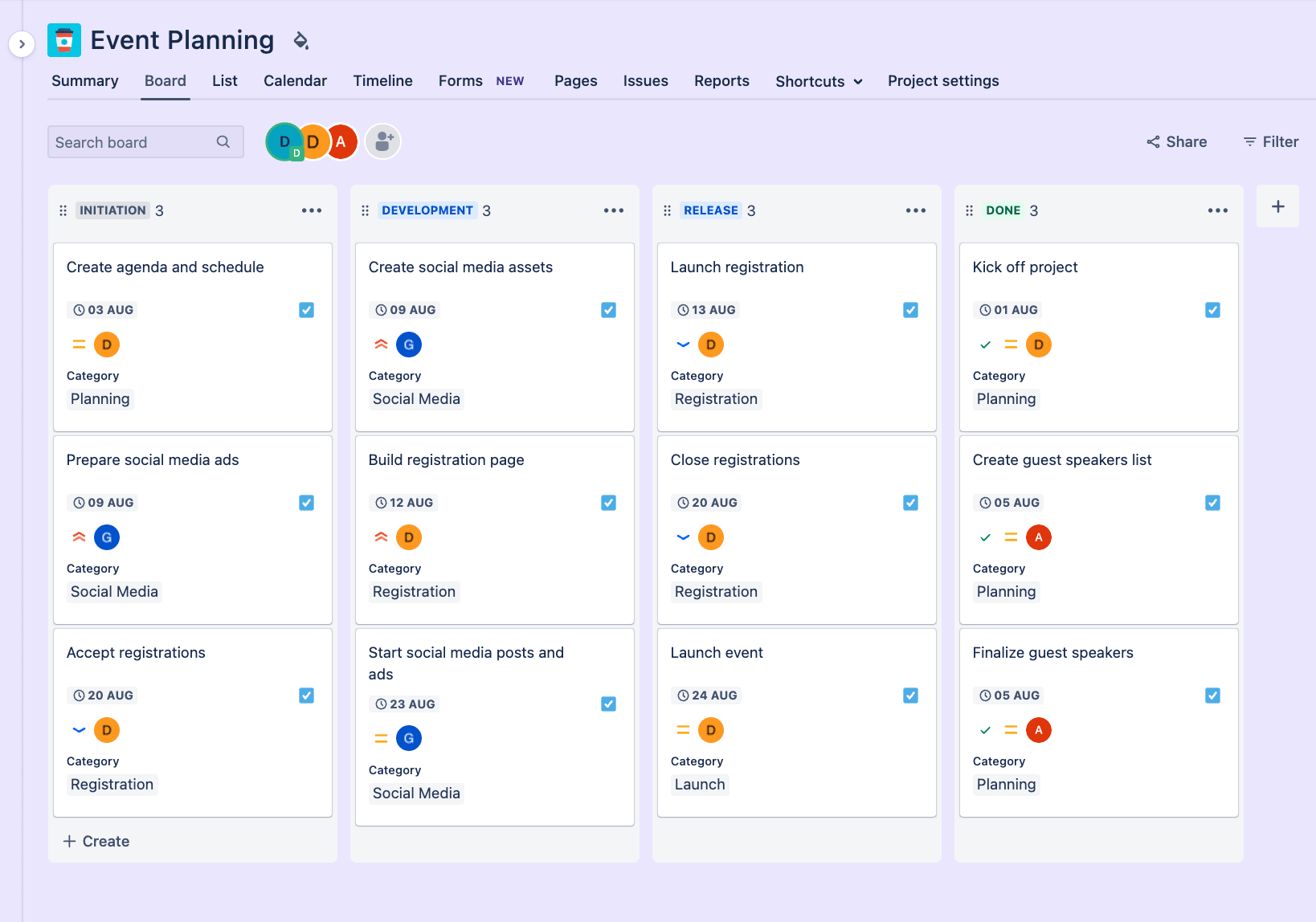
Overall, Jira is also relatively straightforward to use and offers some great features that make it user-friendly. Users like Jira’s dashboard, which offers a number of widgets and customization options to make it easy to see tasks on deck. Additionally, Jira’s right-hand side quickstart bar helps guide users through basic tasks, making it easy to get the hang of.
Jira does feel more clunky than Asana to many users, with some TrustRadius Jira reviews calling it “complicated” and “cluttered” along with comments on how some parts of Jira’s interface are difficult to understand.
Better customer support: Asana
Verdict: Asana offers more customer support options and higher average scores for customer support satisfaction
When comparing software options, look at the different ways customer support is offered along with what other learning resources are available. Here’s a look at Asana and Jira’s support options.
Asana customer support
Asana offers the following resources and support options:
- Online support form
- Help center
- Community forum
- Chatbot for basic questions
- Training, webinars, and courses from Asana’s Customer Success team
- Guides, use cases, and developer’s guide for more details
When you submit a form, someone from Asana’s support team will address your inquiry. Asana claims that its team is available 24/7/365.
Jira customer support
- Online support form to submit a ticket
- Community forum
- Feature suggestions and bug reports
- System status check
- Documentation
Jira’s support is available on weekdays during working hours based on where the company’s local offices are located (there are quite a few around the world). For enterprises, there is 24/7 phone support, but for other clients, they’ll need to wait to get a response to their ticket.
Try monday devStrongest customer reviews: Asana
Verdict: Asana and Jira are neck-and-neck when it comes to customer reviews, and while users of both seem overall satisfied with either platform, Asana comes out on top on review sites
| Asana | Jira | |
| Overall score on G2 | 4.4/5 | 4.3/5 |
| Pros according to users | ||
| Cons according to users |
Browsing customer reviews is a good way to gauge how current or past users feel about the software. Here are the customer review highlights for both tools.
Asana customer reviews
G2 review: 4.4/5 based on over 10,000 reviews
Many reviews mention how users love collaboration features and how user-friendly the software is. Overall, customer service is also positively reviewed on G2, but some users commented on missing features like built-in time tracking for some plans and how the software isn’t equipped enough to handle the demands of more robust project management.
Have a look at Asana’s G2 review page for more insights.
Jira customer reviews
G2 review: 4.3/5 based on almost 6,000 reviews
Jira reviews on G2 state how the customization and collaboration features are great, how it has improved organizations’ project management, and how it’s ideal for development teams. That said, some users have commented that the interface is sometimes not very intuitive, and it can be challenging for non-technical users.
To check out more opinions on the software, have a look at Jira’s G2 review page.
Jira vs. Asana: Which one is right for you?
Essentially, the product you choose will come down to your own preferences. In many categories, Asana and Jira are quite similar, but the teams and use cases where each software is used most often slightly differ.
You should go with Asana if:
- You want a simple yet effective solution
- You want to focus on task management
- You want a solution that’s flexible for multiple teams and use cases
You should go with Jira if:
- You’re a DevOps team or a development-heavy organization
- Your team is already familiar with the Agile format
- You need an issue-tracking platform
Still haven’t found the solution of your dreams? We’d like to introduce ourselves: monday dev—the work, project, and product management platform that lets managers and software teams handle all work their way.
monday dev: the best of both worlds
With monday dev, you have access to a range of features that simplify project management from start to finish, not to mention our incredible customer success agents who are there to guide you 24/7/365 and our 4.7/5 customer satisfaction rating on G2.
monday dev is full of features for collaboration, document sharing, visual boards, task delegation, budget management, and analytics reporting.
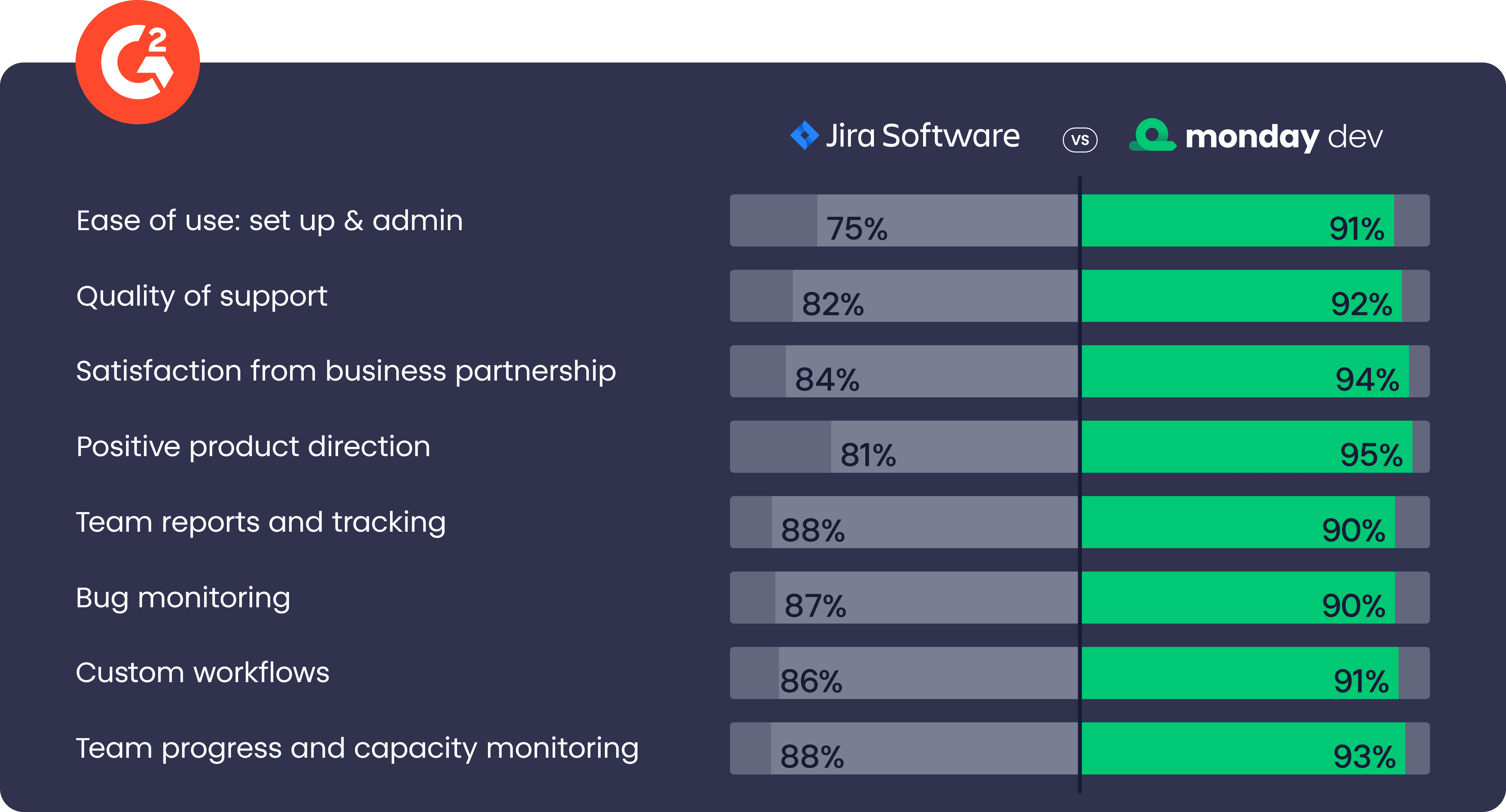
Here’s a small taste of what our platform offers:
- An easy-to-use, visual interface
- Hundreds of ready-made templates like the project tracker template
- 25+ different work views to choose how to visualize your work
- Create, customize, and share forms with team members and clients
- 70+ high-quality integrations and 200+ apps
- Custom automations to put mundane tasks on auto-pilot
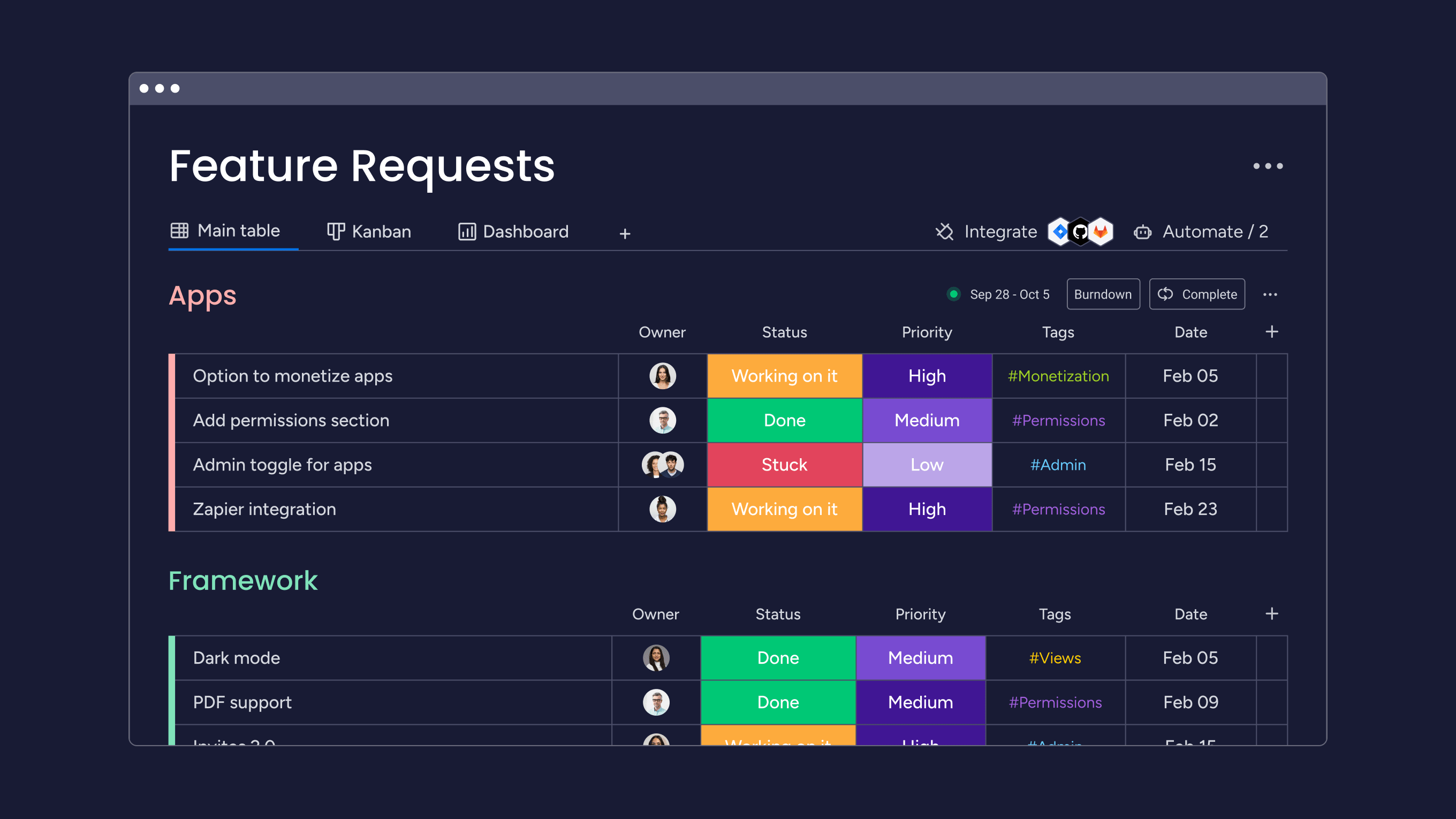
Aside from these features, monday dev is so configurable that it can be used for any industry or type of team – including developers. Built on the flexible monday.com Work OS, we’ve created a unique product designed specifically for development teams. monday dev helps these teams handle everything from product strategy right through to product launch.
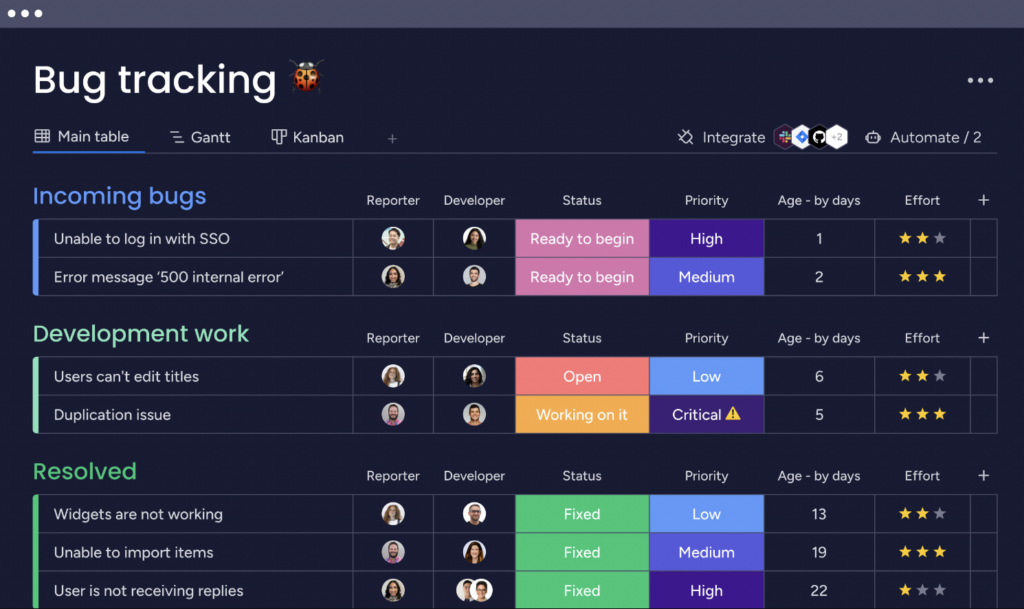
With monday dev, you can manage sprints, create your own automation, use templates for an Agile workflow, and add on integrations with over 200 of the most popular development tools you already use.
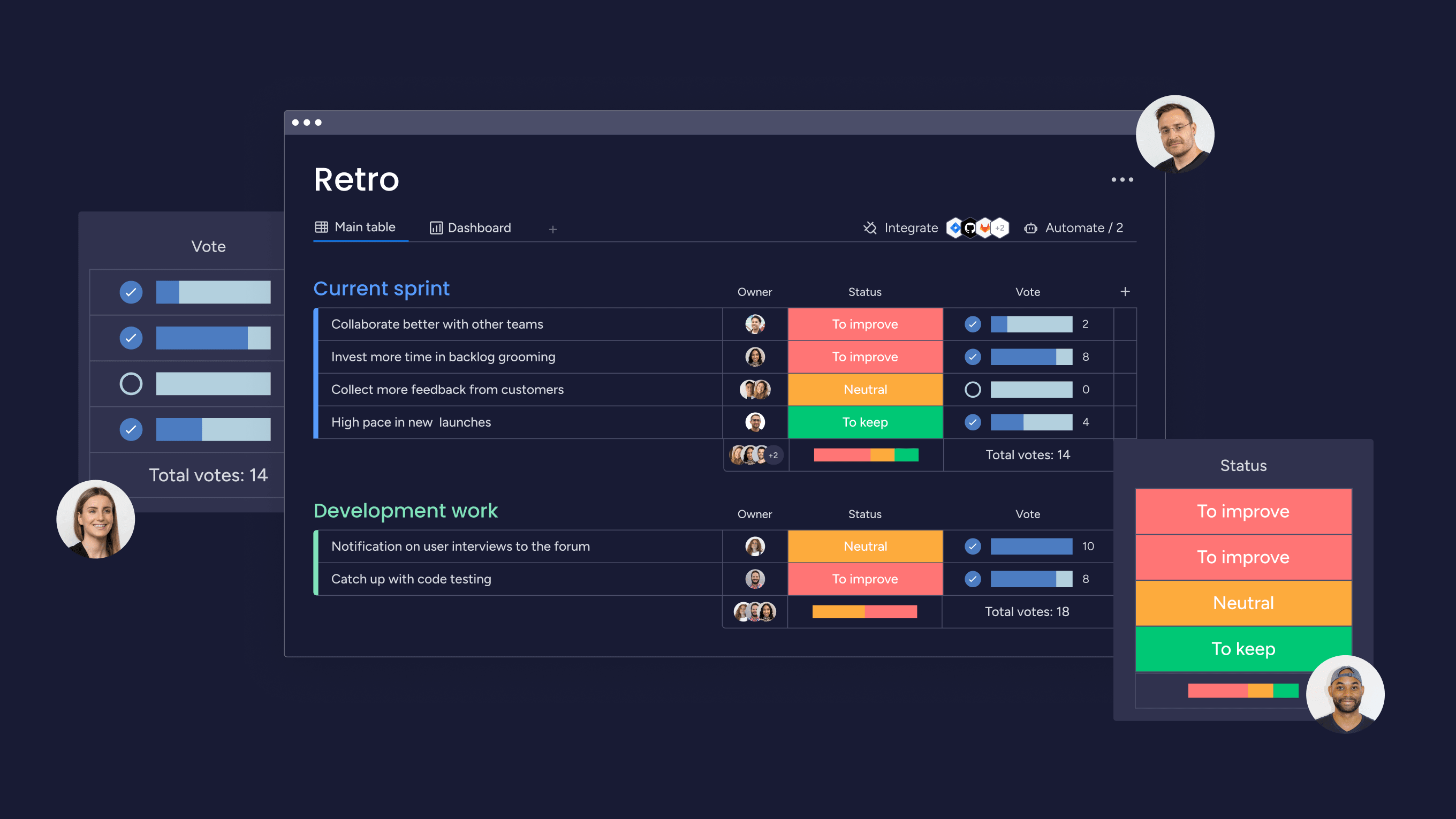
There are built-in templates to help you plan sprints and retrospectives, manage your backlog, customer feature requests, plan your product, and more. Additionally, team members can access dashboards to view burndown charts, sprint progress, team workload, and generate quick Agile reports.
Try monday devThe best project management solution for your DevOps team
While both Asana and Jira make for great options for task and project management, they may not be the best fit for every team. Rather than choosing between the simplicity of Asana and Jira’s dev features, monday dev gives you the best of both worlds. You’ll get an intuitive, easy-to-use interface without sacrificing robust capabilities to track even the most complex development project.
Asana vs. Jira FAQs
Are there free project management software?
Yes, free project management solutions are available but are often free plans of more robust platforms, as is the case with both Jira and Asana. While these free plans can be a good temporary solution for small teams, more businesses may outgrow them and require features found in paid plans.
Is Asana good for small businesses?
Asana is a great choice for small businesses since it has a user-friendly interface and can be a good fit for multiple departments. The plans are flexible and affordable while still offering enough features for task and project management that a small business would need.
What are the main differences between Asana and Jira?
The main differences between Asana and Jira lie in their focuses: Asana is more of a general task management solution, while Jira is more geared toward software development projects. Jira also emphasizes Agile methodologies and bug tracking, while Asana appeals to a wider audience with a simple interface that’s suitable for multiple industries.
 Get started
Get started 


